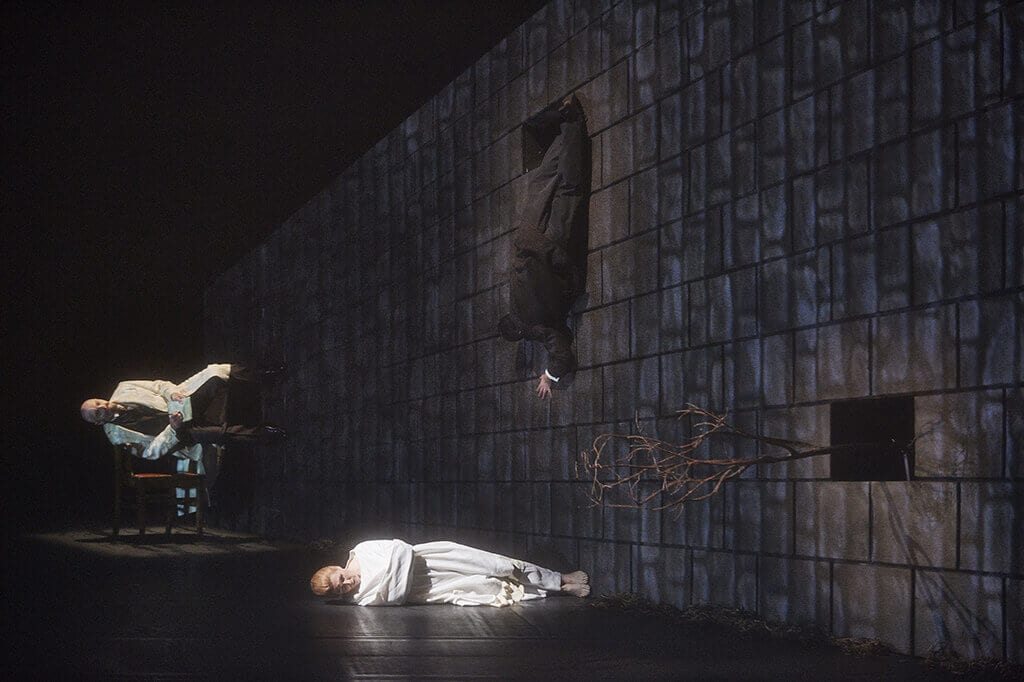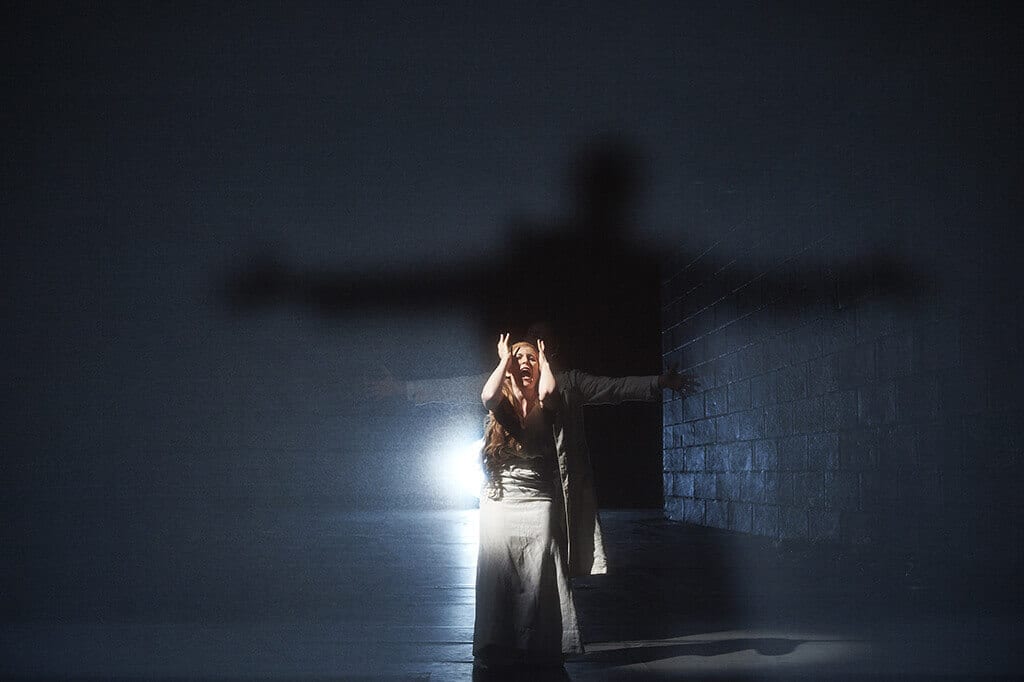Fierce, obsessive, passionate, and confounding, Robert Lepage’s famed production of Béla Bartók’s Bluebeard’s Castle, and Arnold Schoenberg’s Erwartung comes home to Toronto, and after 22 years (and a few revivals) its magic is undiminished, its power as hypnotic as ever. May 2015 must truly be Toronto’s Lepage Spring, as the COC and Canstage reprise iconic works from the early 90s such as Bluebeard’s Castle/Erwartung (1993) and Needles and Opium (1991) that propelled the young Quebec director to international fame.
What makes Lepage’s vision of Bluebeard’s Castle/Erwartung different is his canny ability to marry the experience of spectacle with a profound exploration of humanity’s darkest psychological terrain. There is no element on this stage that fails to speak of hidden trauma, of obsession, of compulsion and fear, of everything that is irrational and unknown. In this, his vision is heightened and complemented by Michael Levine’s powerfully simple and evocative set and costume designs. The walls of Bluebeard’s castle wend their way through the ages into the ballasts of an early 20th century mental asylum that is the setting of Erwartung. As one audience member put it, “Once you’ve seen Erwartung set in a mental asylum, you really can’t see it any other way.” In the artistry of Lepage and Levine, these two early twentieth century works suddenly appear symbiotically linked, as the theme of madness and compulsive desire, and the essentially Freudian anxiety with the liminality of the feminine, speak through myth and madness.
In Lepage’s production of Bluebeard’s Castle, it is impossible to know who holds control in this nightmarish world. This is a story that is ostensibly about a mythical psychopath who imprisons and consumes women who, seduced by his charms, forsake their homes to marry him. Bluebeard’s latest wife, the luminous young Judith, enters his dark castle, and discovering seven locked doors, wilfully demands that he open each one, despite the fact that each room reveals more horror than the previous. Ekaterina Gubanova’s portrayal of Judith is hardly that of a starstruck virgin; this Judith manipulates Bluebeard, she controls and steers herself through the revelation of each horror, and yet, when she says that she loves him, we believe her. Gubanova’s Judith is complex and mercurial, empowered by her belief in her own ability to bring light even to the darkest hour, but also a victim to her addiction to that very darkness. Canadian bass John Relyea outdid himself in his tortured portrayal of Bluebeard. Here is a man bound by compulsion, locked into a cycle of events in which he is an actor; a puppet rather than a puppeteer. Relyea’s voice has the power to menace and seduce, to raise and meet the tempests that the COC orchestra brought out in devilish perfection. The opera concludes when Judith opens the last of the seven doors and discovers Bluebeard’s previous wives alive, but silent as the grave. In a nightmarish scene that evoked Cissy Spacek covered in pig’s blood, the three brides emerge onstage out of a subterranean river of blood to crown Judith and claim her as their own. As the silenced Judith follows the brides into the seventh chamber, we are reminded that there is a sixth character in this nightmarish tale, and that is Bluebeard’s demonic castle. Lepage’s production animates Bluebeard’s castle, giving it a devilish intentionality that feeds off the growing horror of each new scene. At the end of Bluebeard’s Castle we are left with more questions than answers; the kind of questions that remain a lifetime.
Erwartung is a stark, minimalist portrait of a woman’s descent into madness. The plot appears simple: A woman is lost in a forest, seeking a lover who has not kept a tryst. She stumbles on a tree trunk and is consumed by fear, believing it to be a dead body. Driven forward by mounting fear, she discovers a corpse, the corpse of the lover she has sought. Desperately, she clings to him, speaking as if he is alive, berating him for being unfaithful, and finally subsiding, asking herself what meaning her life has, now that her lover is dead. While the plot appears archetypal, it speaks as much to early twentieth century preoccupations with the “hysterical” feminine, as it does to some sort of universal exploration of desire and madness in the female psyche. Lepage is acutely aware of the gendered nature of this work, which he foregrounds, with Levine, by setting this opera in an early twentieth century psychiatric asylum; in Freud’s boudoir, so to speak. And here we see Lepage’s (literally) mind-bending magic at work. As Krisztina Szabó’s outstanding performance as The Woman brought out the terrifying fragility of this character’s wanderings, and the growing malevolence of her descent into madness. The Woman is possessed by uncontainable memories of the lover who suddenly stretches through the nightmarish walls of the asylum which is the tangled forest of her mind. Defying any sense of the real, the tortured characters of The Woman’s past emerge out of walls, her world literally shifting, defying the laws of what we understand to be reality; the woman with whom she claims lover is unfaithful is no other than her doubled self, a weird sister twisted out of a dark mirror. Observing and recording, is a sinister psychiatrist, his objectifying gaze recording the woman’s tortured history with salacious avidity. And yet, in the end, there is a tragic coherence to her journey, and we are left wondering if it isn’t her world after all, her patriarchal prison, that is madness incarnate.
In a profound synthesis of meaning, Erwartung appears to answer the questions set forward in Bluebeard’s Castle; questions which are profoundly existential, gendered, and the very foundation of the great mystery of the human mind. Robert Lepage reminds us that we do not ever really know ourselves. To explore the boundaries of being through the work of this great master is to experience opera as you never have before.



